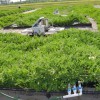 Watermelon is an important crop in Florida and accounts for a significant part of its agricultural water use. Watermelon is grown in open fields and on raised plastic-mulched beds, with the latter being the predominant production system in Florida. Accurate water use estimates for this crop are needed to develop better water allocation and management plans as well as for irrigation management. This publication summarizes the results from a crop water-use study for the drip-irrigated watermelon in south Florida. This 3-page fact sheet was written by Sanjay Shukla, Niroj K. Shrestha, Thomas A. Obreza, and Brian J. Boman, and published by the UF Department of Agricultural and Biological Engineering, August 2014.
Watermelon is an important crop in Florida and accounts for a significant part of its agricultural water use. Watermelon is grown in open fields and on raised plastic-mulched beds, with the latter being the predominant production system in Florida. Accurate water use estimates for this crop are needed to develop better water allocation and management plans as well as for irrigation management. This publication summarizes the results from a crop water-use study for the drip-irrigated watermelon in south Florida. This 3-page fact sheet was written by Sanjay Shukla, Niroj K. Shrestha, Thomas A. Obreza, and Brian J. Boman, and published by the UF Department of Agricultural and Biological Engineering, August 2014.
http://edis.ifas.ufl.edu/ae508
Tag: Drip Irrigation
Using Multi-Sensor Soil Moisture Probes to Decide When and How Long to Run Drip Irrigation
 Several methods of irrigation scheduling are used by producers, including the feel method, calendar method, soil water balance method, and soil moisture measurement method. The latter two methods are superior and help avoid too much or too little irrigation, because they consider the water storage within the plant root zone. The soil moisture method commonly involves measuring soil moisture in the root zone and irrigating when the soil moisture falls below 33% or 50% depletion of available water capacity (water in soil that is available to the plant). This 6-page fact sheet was written by Sanjay Shukla and Nathan Holt, and published by the UF Department of Agricultural and Biological Engineering, July 2014.
Several methods of irrigation scheduling are used by producers, including the feel method, calendar method, soil water balance method, and soil moisture measurement method. The latter two methods are superior and help avoid too much or too little irrigation, because they consider the water storage within the plant root zone. The soil moisture method commonly involves measuring soil moisture in the root zone and irrigating when the soil moisture falls below 33% or 50% depletion of available water capacity (water in soil that is available to the plant). This 6-page fact sheet was written by Sanjay Shukla and Nathan Holt, and published by the UF Department of Agricultural and Biological Engineering, July 2014.
http://edis.ifas.ufl.edu/ae505
Interpreting Dye Test Results for Improved Drip Irrigation Management for the Mulched Vegetable-Production Systems in South Florida
 With Florida’s water withdrawals expected to increase by 30% from 2000 to 2030, South Florida vegetable producers are conserving water by converting traditional seepage irrigation systems to drip irrigation, which can have up to 90% efficiency when used effectively. Dye tests can provide important information for implementing a proper drip irrigation management program. This 6-page fact sheet was written by Sanjay Shukla, Nathan Holt, and Gregory Hendricks, and published by the UF Department of Agricultural and Biological Engineering, July 2014.
With Florida’s water withdrawals expected to increase by 30% from 2000 to 2030, South Florida vegetable producers are conserving water by converting traditional seepage irrigation systems to drip irrigation, which can have up to 90% efficiency when used effectively. Dye tests can provide important information for implementing a proper drip irrigation management program. This 6-page fact sheet was written by Sanjay Shukla, Nathan Holt, and Gregory Hendricks, and published by the UF Department of Agricultural and Biological Engineering, July 2014.
http://edis.ifas.ufl.edu/ae506
Glosario de términos usados en riego por goteo y su traducción al inglés (A Glossary of Drip Irrigation Terms and Their Translations in English) (HS1192)

En esta publicación se presenta el léxico técnico de riego por goteo en dos secciones. En la primera sección se describen en orden alfabético los términos y sus definiciones en español. En la segunda sección se enlista de forma alfabética los términos y sus definiciones en inglés.
This publication includes the drip irrigation lexicon in two sections. In the first section, terms and their definitions are alphabetically described in Spanish. The second section lists terms and their definitions in English in alphabetical order. In both sections, each term includes its respective translation into English or Spanish in parenthesis. This 10-page fact sheet was written by Monica Ozores-Hampton, Dagobiet Morales-Garcia, Eric Simonne, and Viviana Medina, and published by the UF Department of Horticultural Sciences, July 2011.
http://edis.ifas.ufl.edu/hs1192